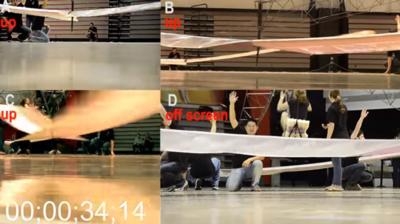Wed, May 11, 2016
The Gamera Project Achieved The Milestone In 2011
On May 12, 2011, biology student and female pilot Judith Wexler flew the human-powered helicopter “Gamera I” for 4.2 seconds in College Park, MD (USA), thus setting the first ever FAI world record in this type of aircraft.

The “Gamera Project” was introduced to try and achieve the dream of human-powered hovering flight. No less than fifty graduate and undergraduate students from the Alfred Gessow Rotorcraft Center of the University of Maryland’s Department of Aerospace Engineering participated in the design and construction of Gamera I. It was made of several lightweight composites and foam, the total weight of this quadrotor helicopter was just about 210 pounds including the pilot. It was built of four trusses, each with a rotor. Both hand and foot pedalling drive the rotors for improved performance. Four cameras were positioned to film the attempt, as the aircraft was so large.
For such records three factors are essential: design, weight, and power. In order to increase the altitude and time in the air, reducing the weight of the aircraft, increasing the efficiency of the rotor design and finding a pilot of just the right size and strength are critical.
Since May 2011, not many records have been set in this very special category. Two months after the first record, Judith managed to supersede her own record with “Gamera II”, a refinement of the “Gamera I”. The current record which was achieved only two years later, is held by Justin Mauch who was airborne for 1 minute and 37.5 seconds. The enormous increase of flight duration between the first and the most recent record shows just how significant and fast the development of human-powered flight has become.
The rules and regulations of Human Powered aircraft are defined in the FAI Sporting Code as an aerodyne that takes off and remains airborne only by direct human muscular energy. It must not use any system of static support such as gas or hot air nor may it carry any kind of apparatus that could receive energy during flight although such equipment may be used to store muscular energy after take-off.
(Source: FAI news release. Image from FAI video)
More News
Aero Linx: The American Society of Aerospace Medicine Specialists (ASAMS) The Society is a non-profit organization created to serve as a voice for and represent the professional ne>[...]
Class C Service This service provides, in addition to basic radar service, approved separation between IFR and VFR aircraft, and sequencing of VFR aircraft, and sequencing of VFR a>[...]
Have A Story That NEEDS To Be Featured On Aero-News? Here’s How To Submit A Story To Our Team Some of the greatest new stories ANN has ever covered have been submitted by our>[...]
Also: ERAU Uses UAVs, P550 Group 2 UAS, Starship’s Florida Launches, NASA Missions Chopped The Air Force has put out a call to commission a one-to-one copy of the Iranian-des>[...]
Classic Klyde Morris From 11.07.16 (and Remembering Bob...) FMI: www.klydemorris.com>[...]
 ANN's Daily Aero-Linx (08.27.25)
ANN's Daily Aero-Linx (08.27.25) ANN's Daily Aero-Term (08.27.25): Class C Service
ANN's Daily Aero-Term (08.27.25): Class C Service ANN FAQ: Submit a News Story!
ANN FAQ: Submit a News Story! Airborne-NextGen 08.26.25: Iran UAV Knockoffs, X-37B Spaceplane, Army Training
Airborne-NextGen 08.26.25: Iran UAV Knockoffs, X-37B Spaceplane, Army Training Classic Klyde Morris (08.25.25)
Classic Klyde Morris (08.25.25)



